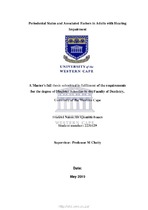| dc.description.abstract | Hearing impairment contributes significantly to the global burden of disabilities and has reported to be a prevalent disability in South Africa. The hearing impaired population has been associated with low levels of oral health due to numerous factors concomitant with reduced oral health care and knowledge. This predisposes these persons to oral disease including periodontal disease.
Aim: To determine the prevalence of periodontal disease and the associated factors in adults with hearing impairment in designated facilities in the Western Cape, South Africa.
Objectives:
1. To determine the oral health care practices in adults with hearing impairment.
2. To determine oral health knowledge of adults with hearing impairment.
3. To determine the frequency of dental visits of adults with hearing impairment and identify any associated barriers.
4. To determine the prevalence of periodontal disease in adults with hearing impairment in designated facilities in the Western Cape, South Africa.
5. To determine the relationship between the prevalence of periodontal disease and associated factors including; sociodemographic factors, oral health care practices, oral health knowledge and frequency of dental visits in adults with hearing impairment.
Methodology: A quantitative, analytical cross-sectional study design was employed. A research questionnaire was used to evaluate oral health care practices, oral health knowledge, frequency of dental visits and related barriers to access oral health care. An intra-oral examination was conducted to determine the plaque index (PI), gingival index (GI) and clinical attachment loss (CAL) using the Ramjford six teeth. Data was analysed in Microsoft Excel and StataCorp using frequencies, means, standard deviations, confidence intervals, Chi-square and Fishers exact tests.
Results: The prevalence of gingivitis was 100% and the prevalence of periodontitis was 26.09% amongst hearing impaired adults. The mean gingival index score (GI) was 1.24 (STD±0.49; 95% CI: 1.14-1.35) and the mean plaque index score (PI) was 1.3 (STD±0.5; 95% CI: 1.2-1.4). Periodontitis prevalence was established for those participants presenting with an average clinical attachment loss (CAL) of >3mm and the mean clinical attachment loss was 4.47mm (STD ±1.41; 95% CI: 4.18-4.76mm) for those presenting with evidence of periodontitis. Age was statistically significant (p<0.05). Prevalence of periodontitis was evident amongst participants over the age of 35 years with a mean age of 48years (STD±13). Oral health care showed a lack of the use of dental floss and regular dental visits. Access to dental care was compromised primarily due to communication barriers, dental fear and a low priority of oral health.
Conclusion: The necessity of oral health care and oral health knowledge in hearing impaired adults such as education and motivation for the need of dental flossing, the use of fluoridated toothpastes and the benefits of regular dental visits, must be emphasized. Oral health care workers should strive to intensify efforts to facilitate a favourable periodontal health status amongst hearing impaired adults. | en_US |

